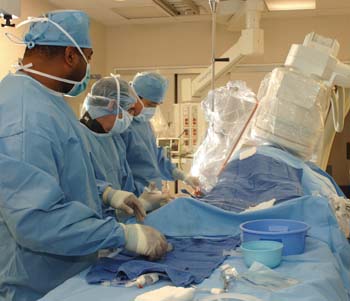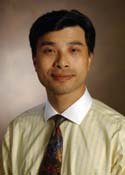
Performing a minimally invasive procedure in the Cardiology Cath Lab are, from left, Scott Guyton, special procedures tech, Jeff Rottman, M.D., and David Zhao, M.D. (photo by Anne Rayner)
VHVI taking novel approaches to complex cases

David Zhao, M.D.
The Vanderbilt Heart & Vascular Institute (VHVI) is poised to become a national leader in treating structural heart disease with minimally invasive techniques.
Two recent cases illustrate just how far this percutaneous interventional approach has evolved to allow physicians to treat complex heart problems in the cath lab rather than the operating room.
In the first, VHVI physicians successfully closed a perivalvular leak in a patient with two mechanical valves – aortic and mitral. The patient had severe anemia, was emaciated, did not respond to therapy and was facing the possibility of a fourth open-heart surgery to repair the leak.
David Zhao, M.D., director of the Cardiac Catheterization Laboratory and Interventional Cardiology, consulted with his colleagues in cardiac surgery and together they decided that the surgical risk was too great.
Instead, Zhao proceeded with a percutaneous closure and successfully sealed the leak.
“Needless to say, the procedure was not easy and took a lot of effort from many people,” Zhao said. “This procedure has only been done in very few top centers in the world, and as far as we know has never been done with both mechanical aortic and mitral prostheses.”
The procedure, which took about two hours, was performed in the cath lab. The Amplatzer device, used to correct the leak, is a silver dollar-sized, wire mesh, mushroom-shaped patch. Physicians at Vanderbilt have been using CardioSeal implants and the Amplatzer device in children and adults for a few years now for percutaneous closure of holes in the hear, both atrial septal defect (ASD) and patent foramen ovale (PFO). The complexity of the cases that they can repair in the cath lab has reached new heights, however.
“While we have done percutaneous work in vessels, we remain one of the few centers that can handle structural heart disease. This requires the physician to be highly experienced and able to adapt to any unique situation with precision,” Zhao said.
Zhao emphasized that a team approach ensured the successful outcome in this case and others like it. Those directly involved included Marshall Crenshaw, M.D., Andre Churchwell, M.D., Jeff Rottman, M.D., Mark Robbins, M.D., Robert Deegan, M.D., Don Cerullo, special procedures tech, Anne Koetz, R.N., Jeff High, heart station tech, Teri Wrenn, R.N., Ida Oudomsouk, R.N., Angie Parker, surgical tech, and Joe Krueger, special procedures tech.
“One of the unique and outstanding characteristics of the Vanderbilt Heart & Vascular Institute is the collaboration that takes place among interventional cardiology, cardiac surgery, cardiac anesthesiology and vascular surgery as we approach these high-risk, challenging cases,” said John Byrne, M.D, chair of the Department of Cardiac Surgery.
Another recent success story involved a female who had suffered an acute myocardial infarction. She developed a complication known as post-infarct ventricular septal defect (VSD). Because of the myocardial infarction, part of the myocardium heart muscle sloughed off, creating a hole in her septum.
“If we did not do anything to her, her mortality was almost 100 percent. Even with a surgical repair, which is the traditional way of doing things, the surgical mortality was 20-30 percent,” Zhao said.
Again, using a catheter and Amplatzer PI muscular VSD closure device, Zhao, Joe Fredi, M.D., assistant clinical professor of Medicine, and their team repaired the hole. The patient was alert within a few hours and went home in a couple of days.
“Success with these types of procedures crystallizes the excellent collaboration within the Institute and are the symbols of world class interventional programs,” Zhao said. “Along with other programs, we are marching forward to become the leader in percutaneous intervention in structural heart diseases.”













